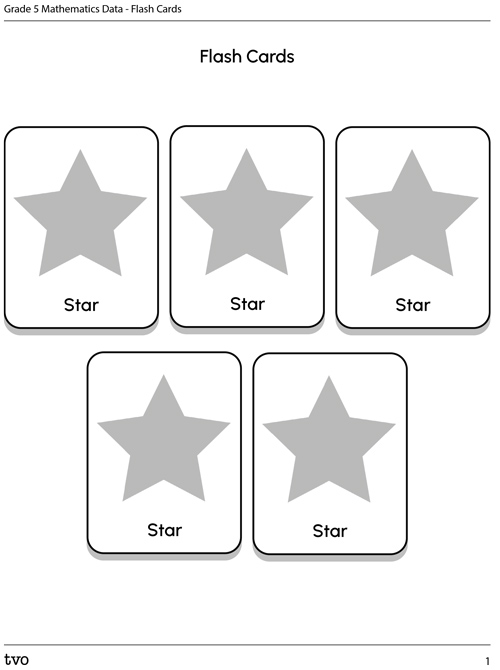Minds On
Inquire!
Examine the following description:

Imagine there are three different kinds of three-dimensional objects inside the bag: 3 square pyramids, 7 cylinders, and 2 cubes.
The set or quantity of items in the bag is 12.
Based on the number of items consider the following questions:
- What object do you predict has the greatest chance of getting selected? Explain your thoughts.
- What is the probability of selecting a cube? How do you know?
Throughout this learning activity, you can record your thoughts digitally, orally, or in print.
Action
Playing with probability
Imagine a coin being flipped 20 times either in person or digitally and the result is shared out loud and in writing. The coin has two options, A and B.
Brainstorm
Brainstorm
How many times do you think Option A will occur? How many times do you think Option B will occur?
How did you make this prediction?
Here is the data collected after 20 trials:
A, B, B, B, A, A, A, A, B, A, B, A, A, B, B, B, A, A, B, A
How close was your prediction to your actual results?
Record your ideas using a method of your choice.
How to make predictions using probability
When making predictions about how often an outcome will occur you need to find the theoretical probability of the outcome first.
For example, imagine we are spinning a spinner with four equal sections or pressing a button that displays the information in written form and out loud.

The theoretical probability of any given section is . So, P (Bear) = , P (Elephant) = , P (Lizard) = , P (Worm) = .
To mathematically determine the number of times we expect a specific outcome on the spinner to occur, we would multiply the number of spins by the theoretical probability.
So, in 12 trials, we would multiply 12 × (or 12 × 0.25) = 3, to determine the number of times an individual outcome should occur. So, each outcome should occur 3 times.
What will happen next?

Check the Flash Cards, wwhich have four possible outcomes labelled on them: a sun, star, moon, and clouds. Predict and then select a card from the pile. When a card is selected record the outcome (the card you selected). Return the card to the pile and shuffle them.
- What card do you think you will pull next? Pick a card and record what you got. Was your prediction, right? Return the card to the pile and shuffle the cards.
- What card do you think you will pull next? How certain are you? Select a card and check your prediction.
Try this game. If you have someone to play with, ask them to play along with you.
Option: Predict what you will select next. If you are correct, you get 2 points. If your prediction is incorrect, you only get 1 point. If you are playing with someone else and your prediction is incorrect, they get the 1 point. Continue playing until you or the other player get to 10 points.
Consolidation
Let's work on few tasks

Task 1: Is this game fair?
Using what you know about theoretical probability, determine if the following games are fair. For each, explain your thoughts and record your ideas using a method of your choice.
- Game A:
- Two players take turns rolling two regular six-sided die (or take turns pushing a button that generates the outcome out loud and in written form).
- If Player A rolls and gets a sum greater than 5, they get 1 point.
- If Player B rolls a sum less than 5, they get 5 points. The first person to get 10 points wins. Is this game fair?
Is this game fair?
-
Game B:
- A digital spinner is used which generates the outcome out loud and in written form.
- The spinner is divided into 16 sections, 8 are labelled with the number 5, and the rest are labelled using the numbers: 1, 2, 3, 4, 6, 7, 8 ,9.
- Every other section is labelled with the number 5; therefore, they are evenly spaced around the digital spinner.
- If the spinner stops on the number 5 the game is won.
- If the outcome is another number, the game continues.
Is this game fair?

Task 2: Think about what you have learned
Answer the following reflection questions using a method of your choice:
- What is important to consider when predicting how many times an outcome will occur when participating or designing a probability experiment or game?
- How might predicting the number of times an outcome will occur help you make decisions about the experiment you are doing or game you are playing?
- Have you ever used probability before to make decisions?
Reflection
As you read through these descriptions, which sentence best describes how you are feeling about your understanding of this learning activity? Press the button that is beside this sentence.
I feel…
Now, record your ideas using a voice recorder, speech-to-text, or writing tool.
Connect with a TVO Mathify tutor
Think of TVO Mathify as your own personalized math coach, here to support your learning at home. Press ‘TVO Mathify’ to connect with an Ontario Certified Teacher math tutor of your choice. You will need a TVO Mathify login to access this resource.
TVO Mathify (Opens in a new tab)